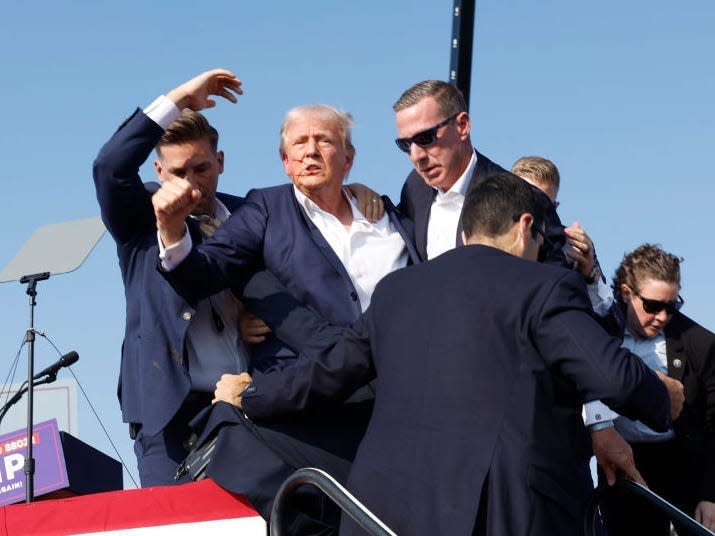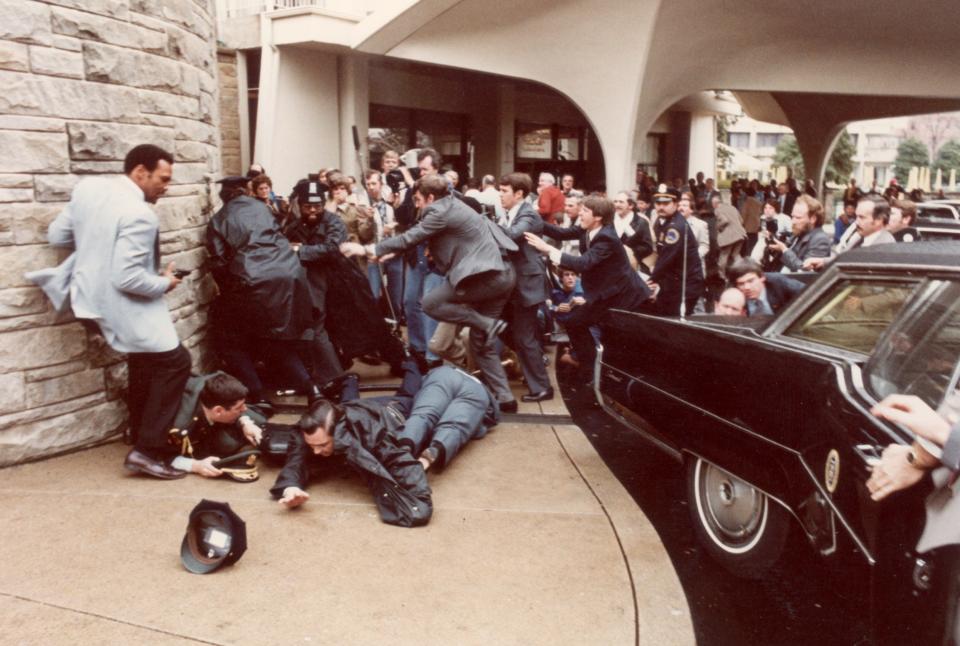The public is outraged the Secret Service appeared to allow a shooter a clear shot of Trump. After Reagan was shot, the agency was widely praised.
- Oops!Something went wrong.Please try again later.
- Oops!Something went wrong.Please try again later.
The Secret Service is under scrutiny after a would-be assassin got in close range of Donald Trump.
After Ronald Reagan was the target of an assassination attempt, the agency faced a lesser reckoning.
In recent years, the Secret Service has been plagued by scandal.
As a gunman fired shots at former President Donald Trump at a rally Saturday, nicking his right ear, US Secret Service agents instantly sprung into action.
The agents surrounding Trump dove on top of him, covering his body to protect him from any more bullets. Another agent, his eye looking through the lens of a sniper rifle, shot the would-be assassin in the head, killing him.
A major question remained: How did the Secret Service let a guy with a rifle get so close to Trump in the first place?
The last time a president or presidential candidate was the subject of a similar assassination attempt was Ronald Reagan.
Back then, the Secret Service faced less of a reckoning.
On March 30, 1981, John Hinckley Jr. got within a few feet of Reagan outside a Washington, DC, hotel where the president gave a speech to union representatives.
Hinckley Jr. fired six times with his pistol. As Secret Service members shoved Reagan into his limousine, one bullet ricocheted off the side of the vehicle, went through the one-inch gap between the limo's body and open door, and penetrated Reagan's left side, breaking a rib and puncturing a lung, according to government records from the time.
The Secret Service came under some scrutiny at that time, too. The US Senate and US House of Representatives each held hearings the following month to evaluate how well the agency did its job. But members of Congress mostly praised agents for their performance and mused on the nature of protecting politicians in open societies. Democratic Sen. Ted Kennedy advocated for gun control legislation.
The Treasury Department, which housed the Secret Service at the time, prepared its own report. The 100-page document, completed in less than a month, reviewed its own procedures and was full of praise for itself, writing that the agents protecting Reagan "reacted in precisely the manner required by their training and the applicable procedures," and recommending awards for the four agents who protected him. The report, prepared by Treasury Department General Counsel Peter J. Wallison, offered a few recommendations for the future, including better ways for the Secret Service to communicate with other federal agencies and having a paramedic travel with the presidential detail.
"In many ways, that transfixing encounter with fate was an easy case: the gunman acted alone; on a weekday; with a low-caliber weapon; in Washington, D.C.; while the President was at the door of his limousine; within a mile or two of a fully equipped and staffed metropolitan hospital; above all, the President's wound was not mortal," the report read. "Anyone can imagine less favorable circumstances, and it is for these that Treasury and other agencies must be prepared."
The Secret Service has been plagued by scandal
Reagan was seriously injured in the shooting, as were a Secret Service agent and DC police officer on the scene. James Brady, his press secretary, suffered the worst injuries, with a bullet to the head that caused lifelong neurological issues.
On Saturday, Thomas Matthew Crooks shot and killed Corey Comperatore, an attendee of the Trump rally in Pennsylvania, and injured two other bystanders, even as he failed at his attempt to kill Trump himself.
By 2024, the Secret Service's longstanding reputation as an elite force has been damaged by controversies in recent years.
Members of the agency deleted text messages from January 6, 2021, making them unavailable for a congressional panel investigating the pro-Trump insurrection attempt. Earlier this year, an agent was removed from Vice President Kamala Harris's detail after reportedly assaulting a superior officer. In 2022, two agents were placed on leave after reportedly getting into a fight with a cab driver in Seoul. A 2015 House panel report faulted the Secret Service for numerous security breaches, which more recent agency leaders have tried to clean up.

Already, congressional oversight is more intense after the Trump shooting than it was after the Reagan shooting. Six committees have demanded answers from the Secret Service, according to Politico: the House Oversight Committee, House Judiciary Committee, House Homeland Security Committee, House Intelligence Committee, Senate Homeland Security and Governmental Affairs Committee, and Senate Judiciary Committee.
Members of each committee received briefings from law enforcement Monday or were scheduled to receive them Tuesday, Politico reported. Kimberly Cheatle, the director of the Secret Service, is scheduled to testify in front of the House Oversight Committee on July 22. Some members of Congress are considering whether to create an independent commission to examine the Trump shooting in the same mold as the Warren Commission that investigated the assassination of President John F. Kennedy, according to The New York Times.
The Department of Homeland Security — which took over control of the Secret Service from the Treasury Department when it was created in 2003 — has already announced a beefed-up security detail for Trump. President Joe Biden also ordered a Secret Service detail for independent presidential candidate Robert F. Kennedy Jr., whose father was killed in a political assassination in 1968 and whose previous requests for Secret Service protection had been denied.
The Reagan assassination attempt investigations focused on Hinckley
The main difference in the government agency reactions in 1981 compared to now is that Reagan's would-be killer was still alive.
Hinckley Jr. was arrested immediately. His motives were readily apparent: He wanted to impress actor Jodie Foster by killing a US president.
At trial, a jury found him not guilty, agreeing with his insanity defense. Hinckley Jr. was placed in a mental health institution and ultimately released in 2016.
The FBI is investigating the Trump shooting, and it isn't clear what actions they'll ultimately take. The motive of Crooks, a registered Republican and reported gun enthusiast, is much less evident.
Representatives for the FBI and the Department of Homeland Security did not respond to Business Insider's requests for comment on whether they'd publish reports about the Trump shooting.

The FBI investigation into Hinckley Jr. was overseen by then-Assistant Attorney General Rudy Giuliani. That investigation focused on building the criminal case against Hinckley Jr. A 1,000-page report — completed just two months after the Reagan shooting — featured interviews with eyewitnesses, medical records, forensic evidence, and a deep dive into Hinckley's past.
In the immediate aftermath of the shooting, members of Congress and the media focused on an earlier incident with Hinckley. He was arrested in Nashville the prior October on weapons charges, possessing guns and handcuffs, when then-President Jimmy Carter visited the city.
Journalists immediately found records related to the arrest, which took up prominent space on the front page of The New York Times a day after the shooting. But Hinckley hadn't been on the Secret Service's internal watchlist, and members of Congress demanded to know why the FBI didn't inform the Secret Service about the earlier arrest.
The Bureau of Alcohol, Tobacco, and Firearms played a role in the investigation, too, tracing the purchase of Hinckley's handgun to a pawnshop in Dallas.
The Justice Department also prepared a memorandum on presidential succession after then-Secretary of State Alexander Haig falsely claimed he was "in charge" at the White House until then-Vice President George HW Bush arrived (the Speaker of the House and President Pro Tempore of the Senate were in line before him).
Congress later passed two significant laws following the shooting. After Hinckley's acquittal, Reagan signed a law in 1984 restricting the use of the insanity defense — shifting the burden from prosecution to the defense in criminal cases. In 1993, with support from Brady and his family, President Bill Clinton signed into law the Brady Act, which regulated handgun purchases, after versions of the law floated through Congress in the aftermath of the shooting.
The Reagan shooting took place in a period of history when attempted and successful assassinations were not uncommon. John Lennon was killed just a few months earlier, and Pope John Paul II was shot a couple of months later. In the Treasury Department report, Wallison wrote that violence struck at the heart of democracy itself.
"What is already clear is that a democratic system which values an orderly transfer of authority through free elections cannot allow the results of these processes to be redirected or reversed by violence," he wrote.
Read the original article on Business Insider

